Abstract Puzzles
As an exercise in developing a generative design practice, each week for a year I designed and produced a jigsaw puzzle.
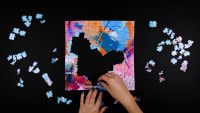
One of the first pieces of generative art I ever made was this Processing sketch. I made it in 2016 at the start of my MA in Computational Arts, and since that day I’d thought it would make a great jigsaw puzzle. I’m not much of a puzzler or a surface designer, but something about the vibrancy and crescent texture of the design made me think it would be joyous to solve as a jigsaw.
This idea festered in my mind for years until, in 2020, I decided to do something about it. The project developed into a weekly challenge to design, produce, and film myself solving a generative puzzle.
I love making generative art but since my masters I’d not done much free exploration of the medium; this challenge gave me an opportunity to experiment with lots of different art styles, as well as hone in on what actually makes a jigsaw engaging and fun to solve.
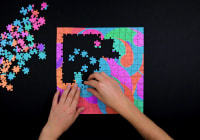
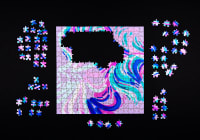
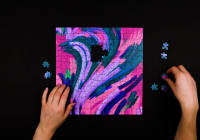
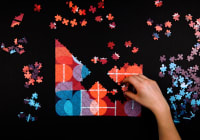
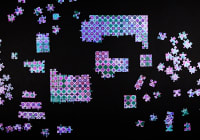
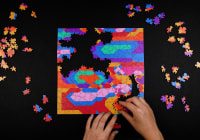
Designing the puzzles
It was important to me to have a development environment that encouraged rapid prototyping and simplified the curation and export processes, so I made a web-based tool tailored to my needs. To make every design reproducible I used seeded randomness with a different seed for each feature of the design; this meant I could tweak individual features of an output to refine the intended effect.
All the designs were made using the JavaScript Canvas API and the cuts were exported as SVGs using canvas2svg.
I also created a website to showcase the outputs and reflect on the experience of solving each puzzle. abstractpuzzl.es uses Next.js and is bundled with a version of my IDE, so you can play with each design yourself. Random designs are also generated on each puzzle’s page to show the versatility of each week’s algorithm; although I only picked one output to produce and solve, each algorithm could produce infinite variations. The code for the entire project is available on GitHub.
Producing the puzzles
Mass-produced cardboard puzzles are made using die cutting but that restricts the cut design to a master shape. I wanted to experiment with the puzzle piece shapes as well as the surface design, so laser cutting was my production method of choice.
Laser cutting produces a lot of smoke which scorches the surface of the material, usually that doesn’t matter because the material would have a protective coating but for jigsaws the surface needed to be the printed design (I was not up for peeling plastic of hundreds of individual puzzle pieces each week!).
I spent 6 months experimenting with different materials and laser settings to make tactile, vibrant, scorch-less puzzles. The designs were giclée printed on Hahnemühle Pearl paper by theprintspace, mounted to 3mm acrylic in frosted black, and laser cut by Swordfish Works.
The future of Abstract Puzzles
When I designed the 50th puzzle in September 2021 I didn’t intend for it to be the last one. I was moving to a new city and was excited about finding local printers and fabrication studios to work with on the production side, but then I started a new job and caught COVID (the long kind, where over a year on looking at an incomplete jigsaw makes my brain fizz) so I haven’t been able to invest in this project ever since.
I would dearly love to come back to it because I think I’ve barely scratched the surface of playing with the form of a puzzle, and while I’ve gained a greater understanding of how different elements of the surface design contribute to the difficulty and enjoyment of a puzzle, there are endless generative art styles that I’d like to try in puzzle form.
I will come back for you, puzzles! Also if you happen to work for a jigsaw factory and want to collaborate on producing a line of generative puzzles, hit me up.